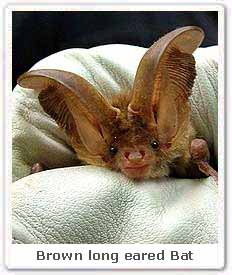| Kingdom : | Animalia |
| Phylum : | Chordata |
| Class: | Aves |
| Order : | Chiroptera |
| Family : | Vespertilionidae |
| Genus : | Plecotus |
| Species : | P.auritus |
| Zoological name : | Plecotus auritus |
| Found In | Bharatpur Bird Sanctuary and Sultanpur Bird Sanctuary in India |
 Physical appearance : Brown long eared Bat is a medium
size Bat with the pink brown face.. It is 4.2- 5.3 cm long and weigh up to 5
– 12 grams. Their fur is buff brown in colour. They have long and
woolly fur. The females are slightly larger and heavier than the males. The
ears and wing membrane are a light gray brown. They have strikingly large
oval shaped ears that are almost as long as the body. At rest, their ears
are tucked back and folded, resembling ram horns. Their ears are as longer
as the body and exceeds to 28 mm. It has broad wings measuring 24 -28 cm.
Females are larger and heavier than the males.
Physical appearance : Brown long eared Bat is a medium
size Bat with the pink brown face.. It is 4.2- 5.3 cm long and weigh up to 5
– 12 grams. Their fur is buff brown in colour. They have long and
woolly fur. The females are slightly larger and heavier than the males. The
ears and wing membrane are a light gray brown. They have strikingly large
oval shaped ears that are almost as long as the body. At rest, their ears
are tucked back and folded, resembling ram horns. Their ears are as longer
as the body and exceeds to 28 mm. It has broad wings measuring 24 -28 cm.
Females are larger and heavier than the males.Presence in India : Brown long eared Bat is found in the Central and Western parts of India. They are spotted in many bird sanctuaries in India especially Bharatpur Wildlife Sanctuaryand Suntanpur Bird Sanctuary in India.
Habitat : Brown long eared Bat prefers open forests, deciduous woodland, orchards and parklands. They roosts in old buildings.
Diet : Brown long eared Bat feeds on moths, beetles, flies, earwigs, caddis flies Caterpillars, spiders, twigs and leaves. They search for food during the night.
Reproduction : Brown long eared Bats mate during the autumn season. Females usually mates with many males. Males produce the greatest amout of sperm in the month of August and September. One young is born between mid June to July end. New born open their eyes on the 4th day of the birth and their ears become erect on the following 11th day. Yong ones are pale gray in colour. Young ones starts flying before one month and are weaned at about month and a half. They are weaned and able to fly by the end of July.
Conservation status : Brown long eared Bats are not considered as threatened. They are listed as vulnerable by the IUCN. They are present in large numbers.
Lifespan : Average longevity of the Brown long eared Bat extends up to the 4 years of age and the maximum to the 30 years of age.






